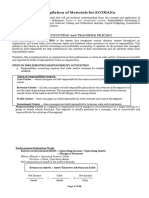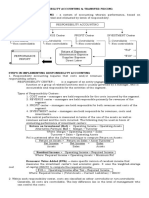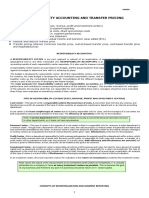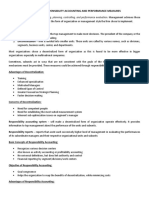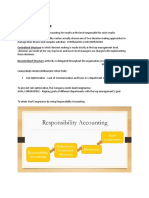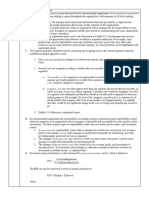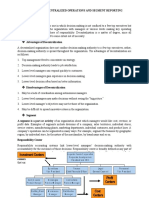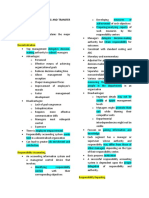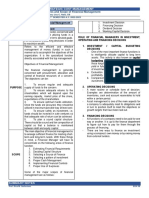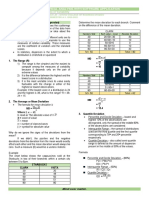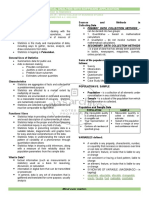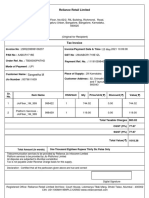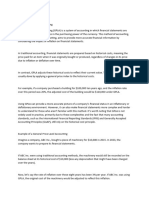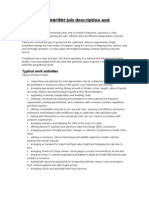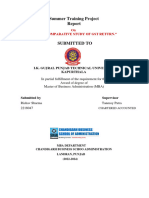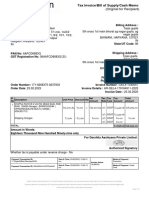STRACOSMAN: STRATEGIC COST MANAGEMENT
CHAPTER 3: Management Accounting Concepts and Techniques for Performance Measurement
SUMMARY NOTES BY: Mary Joy C. Nala, CB
BS ACCOUNTANCY 3B | 2nd SEMESTER A.Y. 2022-2023
Responsibility Accounting and Transfer Pricing Direct Costs Common Costs
Are organization sustaining
Direct fixed costs are fixed costs fixed costs that are allocated to
TERM DEFINITION that can be directly traced to the the segment. These fixed costs
It is a responsibility center in which the segment. Just because a fixed will continue even if the segment
manager has the authority only to incur cost is direct does not mean that has been eliminated; they will
Cost it is avoidable. just be allocated to the
costs and is specifically evaluated on the
Center remaining segments.
basis of how well costs are controlled and
utilized.
Performance Margin (Manager Versus Segment
A revenue center is an organizational unit
Performance)
for which a manager is accountable only
Revenue
for the generation of revenues and has no
Center RESPONSIBILITY CENTER EVALUATION
control over setting selling prices or MANAGER TECHNIQUES
budgeting costs. Cost center manager Cost variance analysis
A profit center is a responsibility center in Revenue center manager Revenue variance analysis
Profit center manager Segment margin analysis
which the manager is responsible for Return on Investment (ROI),
Profit generating revenues, planning and Residual Income Model,
Investment center manager
Center controlling expenses in his center. Most of Economic Value Added
the time a profit center exists rather than (EVA), etc.
a purely revenue center.
Preparation Of ‘Segmented’ Income Statement
An investment center is an organizational
unit in which the manager is responsible Sales xx
for generating revenues, planning and Variable Costs (xx)
Investment controlling expenses, and has the Manufacturing Margin xx
Center authority to acquire, utilize, and dispose of Variable Expenses (xx)
assets in a manner that would seek to Contribution Margin xx
earn the highest feasible rate of return on Controllable Direct Fixed Costs and Expenses (xx)
the center’s investment cost. Controllable Margin xx
Non-controllable Direct Fixed Costs and Expenses (xx)
Concepts Of Decentralization and Segment Reporting Segment (Direct) Margin xx
DECENTRALIZATION SEGMENT REPORTING Indirect (Allocated) Fixed Costs and Expenses (xx)
Segment reporting is the
Operating Income xx
Is a form of organization’s reporting of the operating
management style where segments of a company in
Return on Investment (ROI)
the firm is divided into the disclosures
ROI = Segment Profit / Segment Investment
smaller units. These units accompanying its financial
ROI = Profit / Net Sales x Net Sales / Investment
are called by various statements. Segment ROI = Return on Sales x Assets Turnover
names, such as divisions, reporting is required for
segments, business units, publicly-held entities, and Residual Income (RI)
center, and departments. is not required for privately RI = Segment Income – Minimum Income (MI)
held ones. MI = Investment x Implied Interest Rate
Controllable Costs Non-controllable Costs Economic Value Added (EVA)
The non-controllable costs EVA = Operating Profit after Tax (OPAT) – Minimum Income
If a department has authority
are those costs that a OPAT = PBIT x after-tax rate
and responsibility for certain
department doesn’t have MI = Investment x weighted average cost of capital
costs, those costs are called
authority over and can’t
controllable costs.
change.
SUMMARY NOTES
Prof. Rica M. Quitoriano BSA 3B
� STRACOSMAN: STRATEGIC COST MANAGEMENT
CHAPTER 3: Management Accounting Concepts and Techniques for Performance Measurement
SUMMARY NOTES BY: Mary Joy C. Nala, CB
BS ACCOUNTANCY 3B | 2nd SEMESTER A.Y. 2022-2023
Transfer price is the price at which divisions of a company The four most commonly employed perspectives are as
transact with each other, such as the trade of supplies or labor follows:
between departments. Transfer prices are used when individual
entities of a larger multi-entity firm are treated and measured as a. Financial Perspective – employs financial
separately run entities. A transfer price can also be known as a measures of performance used by most firms.
transfer cost. (i.e., ROI and employee turnover).
TERM DEFINITION b. Customer Perspective – evaluates how well
A company that transfers goods between the company is performing from the viewpoint
Minimum multiple divisions needs to establish a transfer of those people who buy and use its products.
Transfer Price price so that each division can track its own
efficiency.
c. Internal Process Perspective – evaluates all
The best transfer price is market price. Because
critical aspects of the value chain (product
individual business units or segments have to
development, production, delivery and after-
compete with the rest of the world, they have to
Market-Based sale service) to ensure that the company is
beat the prevailing market price to stay
Transfer Price operating effectively and efficiently.
competitive. They have to follow the market
streams of capitalistic model or free enterprise
system. d. Learning and Growth Perspective –
A cost-based transfer price equals cost plus a evaluates how well the company develops and
lump sum or a markup percentage. Cost may retains its employees by evaluating employee
either be standard or actual cost. Standard cost skills and satisfaction, training programs, and
Cost-Based has the advantage of isolating variances. Actual information dissemination.
Transfer Price costs give the selling division a little incentive to
control costs. Actual cost-based transfer pricing
does not promote long-term manufacturing
efficiencies.
Negotiated transfer price may occur when
segments are free to determine the prices at
which they buy and sell internally. It is especially
Negotiated appropriate when market prices are subject to
Price rapid fluctuations. It reflects the best bargain
price acceptable to the selling and buying
divisions without adversely sacrificing their
respective interests.
BALANCED SCORECARD
The primary purpose of the Balanced Scorecard is to translate
an organization’s vision, mission, and strategy into a set of
performance measures that put that strategy into action with
clearly-stated objectives, measures, targets, and initiatives.
PERSPECTIVES OF BALANCED SCORECARD
SUMMARY NOTES
Prof. Rica M. Quitoriano BSA 3B




